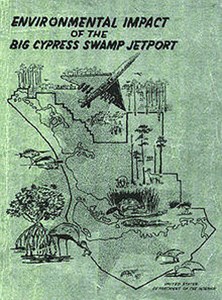
Spurred by increasing growth and the rapidly expanding population of South Florida, the state wanted to build a jetport that would support the growing community through futuristic aspirations of aircraft capable of carrying up to 1,000 passengers each, and capable of flying coast-to-coast in supersonic time. In the early to mid-1960s, plans for the “World’s Largest Jetport” became public. 
When the report was released in 1969, the report began by stating: "Development of the proposed jetport and its attendant facilities will lead to land drainage and development for agriculture, transportation, and services in the Big Cypress Swamp which will inexorably destroy the south Florida ecosystem and thus the Everglades National Park." Alarmed by what the research suggested and the threat to an end of their traditional way of life, a coalition of hunters, conservationists and citizen activists, including, Marjory Stoneman Douglas, and the newly formed Friends of the Everglades, pressured the port authority to find another location for the jetport. The coalition was aided in no small part by Dr Luna Leopold's environmental impact study. In 1970, work on the jetport was halted through the Everglades Jetport Pact, which resulted in the port authority immediately instituting measures to search for another jetport location. Today, located along the eastern boundary of Big Cypress National Preserve, the 24,960 acre Dade-Collier Training and Transition Airport (also known as TNT) consists of only one runway, and is used as an aviation training facility. Encompassing it, is Big Cypress National Preserve. It was established on October 11, 1974, by President Gerald Ford, as the nation's first national preserve, set aside to:

|
Last updated: August 1, 2025
